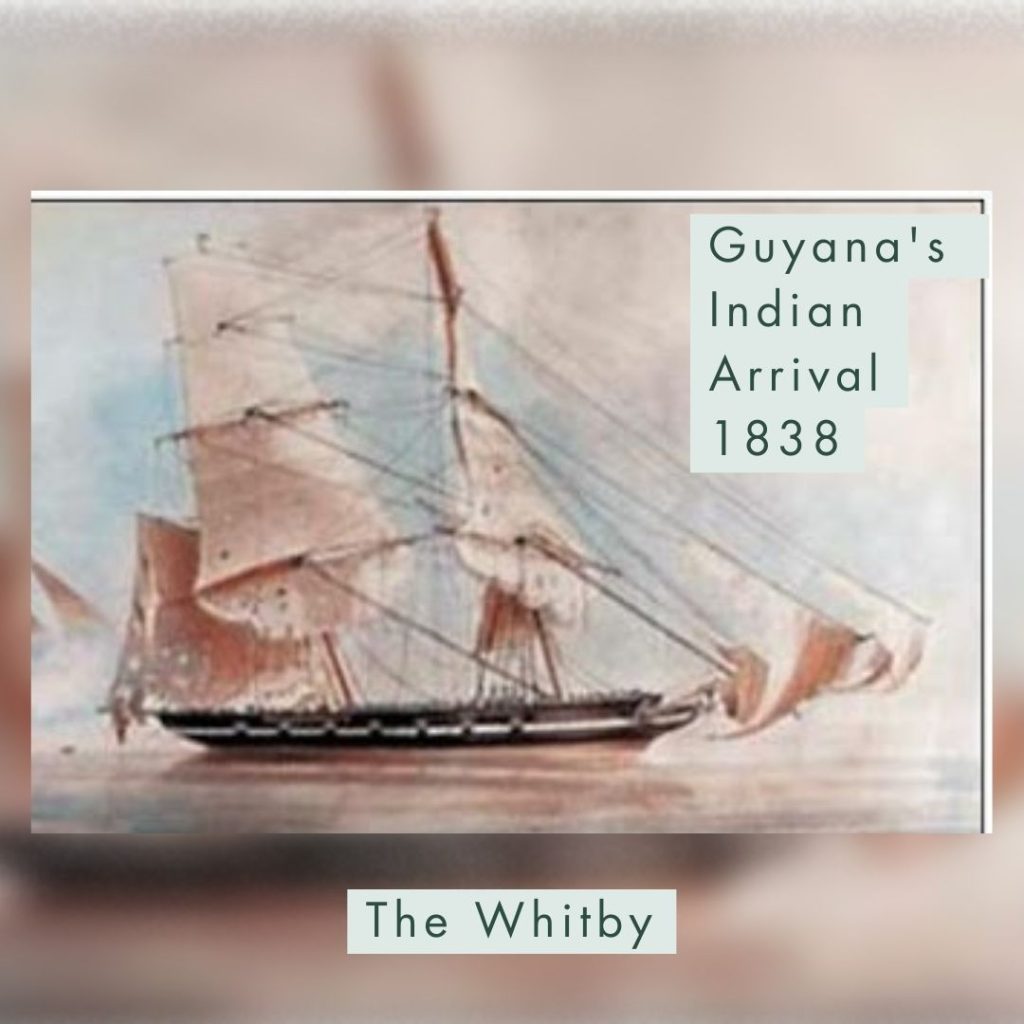The Whitby and Hesperus: The First Indian Indentured Servant Ships to Guyana
This article is about the Whitby and Hesperus ships, the first ships that brought Indian indentured laborers to Guyana.

Guyana's Indian Indentured Servitude Background
In 1838, the Whitby and Hesperus ships would forever change the course of the Indian disapora involved in the indentured servitude system.
On January 13, 1838, the Whitby left India for Guyana with the first set of Indian indentured servants.
After slavery was abolished, the British planters sought workers to replace the enslaved Africans. John Gladstone, a West-Demerara sugar plantation owner, sought permission from the British to import Indians to work for a period of 5 years under the indentured servitude system. The British granted his request.
Gladstone and other sugar plantation owners then arranged to import 414 Indians to Guyana. The Indians originated from Chota Nagpur, Burdwan, and Bancoorah (near Calcutta). Those from Chota Nagpur were referred to as “hill coolies.” “Coolie” was a corruption of the tamil word “kuli,” which meant laborer.
The British plantation owners chartered two ships to transport the first set of Indians to Guyana.
The Whitby and Hesperus Arrive in Guyana
First, the Whitby set sail on January 13, 1838. Of the 249 indentured (233 men, 5 women, and 6 children) on this ship, five passed away. They voyaged 112 days and arrived in Guyana on May 5, 1838.
Second, the Hesperus left Calcutta on January 29, 1838 and also arrived in Guyana on the night of May 5, 1838. Of the 165 passengers, 13 died, leaving 135 men, 6 women, and 11 children. Dr. Theophilus Richmond oversaw the health of the passengers on this ship.
On this voyage, he tended to a mother and her three children. She suffered from cholera and was too dehydrated to nurse her infant baby. Her other two children, ages 4 and 5, were also inflicted. Her husband watched helplessly as the doctor tried to administer aid. They would arrive in Guyana on May 5th, 1838-- the same day as the Whitby ship.
So what happened after they landed? They were first assigned to the Plantation Highbury.
Tragically, the females were assaulted and murdered in alarming numbers. The violence was primarily caused by the disproportionate rate of women to men on the ships.
An unfortunate instance involves one of those 11 girls. Her name was Nunneedy. Nunneedy was just 8 years old when she died a few months after arriving in Guyana. She was assaulted and “died in consequence of her person being violated by some man unknown.”
The local governor offered a reward for Nunneedy's assailant but no one was named or caught. In 1839, the magistrate visited Plantation Belle Vue, where Nunneedy was killed. He only spoke with two Indian women and the case, accordingly, was not solved.
The conditions were so inhumane for the first set of indentured servants, also known as the "Gladstone Coolies," that the British implemented a 5 year moratorium on the transport of Indian indentured servants. When indentured servitude resumed, the ships were required to have a minimum quota of women to men.
For the next 79 years, nearly 239,000 Indians journeyed to Guyana and nearly 148,000 Indians went to Trinidad as indentured servants. The majority of these workers would never return to India.
The Indian indentured servants who emigrated to the Caribbean, the formerly enslaved Africans, and the other Caribbean populations, would go on to form a distinctly unique culture.
Thankful for all Guyanese and Trinidadian ancestors from India. And the ancestors from Africa from which we all derived– but that’s a (surprisingly under-shared) story for a different day.
FAQ: The Arrival of East Indians in the Caribbean
1. What is the significance of May 5th in West Indian history?
May 5th marks the historic event of the arrival of the first ships, the Whitby and the Hesperus, in the colony of British Guiana. This day is commemorated as East Indian Arrival Day in Guyana, celebrating the valuable contributions of the first Indian indentured labourers to the West Indian islands.
2. Why were Indian labourers brought to the British colonies like Guyana and Trinidad?
Following the abolition of slavery, British planters and owners of sugar plantations faced labor shortages. The motivating factor for bringing Indian immigrants was the need for workers on sugar estates. These laborers, including those from Chota Nagpur, signed deceiving contracts for a five-year period of indenture or were kidnapped.
3. Who was John Gladstone, and how was he involved?
John Gladstone, a West Demerara sugar plantation owner and the father of the British statesman, petitioned the British parliament for permission to import East Indians. He initiated the process, which brought the first set of East Indian laborers to Guyana aboard the Whitby ship.
4. What was the experience of the first Indian indentured labourers?
The first set of Indian laborers endured long voyages aboard the first ships like the Whitby and Hesperus, which set sail in January 1838. They faced harsh working conditions, a high death rate, and gender imbalance. This led to a moratorium on indentureship. Their hard work laid the foundation for future generations, despite the ongoing struggle for fair treatment.
5. Why was there a five-year moratorium on Indian indentured servitude after 1838?
Reports of inhumane conditions and ill-treatment by estate owners and the colonial police led the British to pause indentureship for five years. Changes, including a per cent ratio of women to men, were introduced when the system resumed.
6. What is Plantation Highbury, and why is it significant?
Plantation Highbury is one of the locations where Indian immigrants first worked. It holds a bronze sculpture of the steamship to honor the ancestral connections of the first set of Indians who arrived.
7. Are there any monuments commemorating Indian arrival?
Yes, several landmarks, such as the Indian Arrival Monument honor the extensive contributions of Indian labourers.
8. What cultural influences did Indian immigrants bring to the Caribbean?
Indian laborers introduced colourful Phagwah, Muslim religion, and other Indian festivals to the Caribbean. They retained strong cultural ties to their heritage despite being far from the land of their birth.
9. How did Indian indentured labor affect other colonies like Trinidad and South Africa?
The system of indentured labor extended beyond Guyana to Trinidad and South Africa, and other colonies. In these regions, Indian immigrants similarly worked on plantations, blending their culture into local societies.
10. What role did caste system and last names play in Indian indentured society?
Many Indian laborers came from lower castes. Upon arrival, some adopted new last names as the surname system was not common place.
11. Who was Nunneedy, and what does her story reveal?
Nunneedy, a young girl from the first batch of Indians, tragically died due to violence shortly after arriving. Her case, unsolved by authorities, highlights the dangers faced by women during the period of indentureship.
12. How are East Indians remembered in the indentureship system?
Today, descendants of Indian indentured servants honor their ancestors’ resilience while forging their own paths.
Main References
Coolie Woman
The Guyana Story
https://scalar.lafayette.edu/indoguyanesewomenpoets/media/whitby-and-hesperus
https://www.thingsguyana.com/whitby-the-way-east-indian-came-to-british-guiana/
#education #indianarrivalday #indiansurvivalday #guyananice

This article was about the Whitby and Hesperus ships, the first ships that brought Indian indentured laborers to Guyana.
By Melissa Ramnauth, Esq. | This content is copyright of West Indian Diplomacy, LLC and may not be reproduced without permission.

She runs West Indian Diplomacy, a Caribbean blog aimed at promoting West Indian history and business in the global marketplace. Melissa has been an attorney for over 10 years. She currently focuses on trademark registration, trademark searches, and office actions. She also has extensive legal experience in the areas of trademarks, copyrights, contracts, and business formations. She owns her own Trademark Law Firm that is virtually based out of Fort Lauderdale.
Please Sign Our
Petition to Preserve Our Ship Records
By Submitting this Form
Disclaimer: This post is for informational purposes only and does not constitute legal advice. Please see our Terms & Conditions and Privacy Policy for more information regarding use of this site. All information is true and accurate to the best of our knowledge. The information on West Indian Diplomacy is “as is.” We make no representations or warranties, express or implied, with respect to the content provided on this website or on any third-party website which may be accessed by a link from this Web site, including any representations or warranties as to accuracy, timeliness, or completeness. West Indian Diplomacy will not be liable for any losses, injuries, or damages from the display or use of this information.
Thank you for your article. I am trying to find where my grandparents came from, where they left from, in India. They left India for Guyana between 1838-1900. Trying to find my roots/ancestry. Do you have any advice on where to start?
Thanks